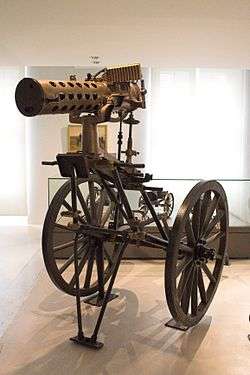Antoine Treuille de Beaulieu

Antoine Hector Thésée Treuille de Beaulieu (7 May 1809 – 24 July 1885) was a French General of the 19th century, who developed the concept of rifled guns in the French Army.[1] He studied the subject of rifling between 1840, particularly in the famous Manufacture d'armes de Châtellerault, and 1852.[2] Following a request by Napoleon III in 1854 to develop such a weapon, the de Beaulieu system was adopted by the French Army. It consisted in cutting six grooves inside the bore of a muzzle-loading cannon, and to use shells equipped with six lugs which would engage the grooves.[3] This development was paralleled by that of the Armstrong gun in Great Britain (adopted in 1858 by the British Army).[3]
These developments led to the introduction of the La Hitte system in 1858, a fully integrated system of muzzle-loading rifled guns. The Beaulieu 4-pounder rifled field-gun was adopted by the French Army in 1858, where it replaced the canon-obusier de 12, a smoothbore cannon using shells which was much less accurate and shorter-ranged.[4]
The Beaulieu rifled artillery was first used in Algeria, and then in the Franco-Austrian War in Italy in 1859.[5]
Notes
- ↑ A Dictionary of Military History and the Art of War by André Corvisier, p.44
- ↑ Journal By Royal Society of Arts (Great Britain), p.617
- 1 2 A Dictionary of Military History and the Art of War by André Corvisier, p.45
- ↑ "...the introduction by the French army of the Beaulieu 4-pounder rifled field-gun in 1858: the new artillery, though much more accurate and long-ranged than the smoothbore 'canon-obusier' it replaced (which, incidentally, was the most prevalent artillery piece of the US Civil War), was not suited to firing anti-personnel case-shot (which, in French, is called 'mitraille')." in The Mitrailleuse by Dr. Patrick Marder Military History Online
- ↑ "Beaulieu rifled artillery was first tentatively used in Algeria but received great acclaim only during the Italian War of 1859." in The Bloody Crucible of Courage by Brent Nosworthy p.644
